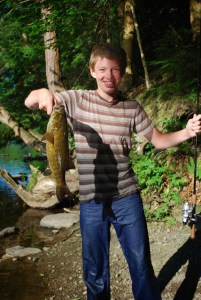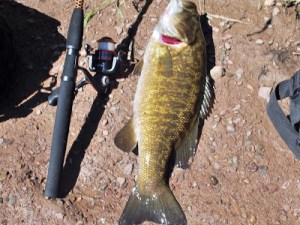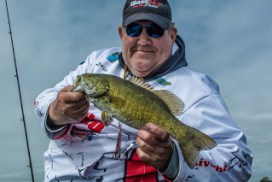Senko Smallies
Senko-style worms long ago eclipsed the popularity of traditional and twister-tail plastic worms for use in shallow and middle depths, especially when rigged Wacky style- hooked in the middle. Typically, the hook is attached by an O-ring, which prevents the worm from breaking free. A tool specifically designed for placing the ring on these worms is commonly available. Most anglers intend Senko-style worms for largemouth, but in my experience over the last decade, I’ve actually caught most of my largemouths on traditional-style worms, and most of my smallmouths on Senko-style worms. They sink faster, provoking the quicker responses of smallies. By comparison, largemouths are slower on the attack. An aggressive smallmouth will charge a worm plummeting towards bottom, which a largemouth might refuse.

Lakes, reservoirs, ponds, streams, rivers—during summer you can enjoy catching smallmouths on all five types of water. None excludes use of the Senko. While much gets written about smallies hanging on 20 to 25 foot lake drop-offs, plenty get caught close to shore in water three to 15 feet deep, so long as rocks provide habitat. Summer smallies ambush prey eagerly compared to largemouths. From comfortable lairs in concave formations, or from between and underneath rock, smallies explode like artillery fire to snatch meals. Smallies can seem as active during summer as largemouth are during fall. Much of the time—though not always—I let them pounce on a Senko, rather than provoke them to chase down a crankbait or whomp a spinnerbait. Bronzebacks will strike a wide range of lures during the summer doldrums, and I’m interested in increasing my knowledge of that variety, but most often I feel comfortable with the simple approach.

There’s an irony about that claim of simplicity. Fishing a Senko, with no weight added, on a size 2 plain shank hook under the O-ring, involves wider awareness than the use of other lures where the key factor is limited to varying the retrieve. I wouldn’t say turn-handle retrieves are mechanical, but they do narrow the angler’s focus to the line reeled back to the spool. On the other hand, during the patient intervals while the Senko sinks, you repeatedly pause, taking up line due to varying the movement of the rod— action more significant than just turning the reel handle. The mind has to open up to what might happen, and this added awareness can put you more in touch with the fishing to gain practical results.
Even topwater plugs fished slowly might not have the subtle appeal of letting a Senko sink slowly as deep as 15 feet or more among rocks. During the decent, you are wondering all the while if a bass will transmit a tick before that plastic reaches bottom. If nothing happens, you can visualize how much the Senko flutters when you barely twitch it. Maybe you then give it a jerk to make the ends pull back quickly like spreading crayfish claws–that could do the trick. Or instead, just by lifting it off bottom, it might seem to the fish as the forage is trying to sneak by. The possibilities are as many as the given situation and imagination allow- and imagination is just as important for envisioning what goes on under the surface as the feedback electronics can provide. Looking at a screen seems a lot easier than developing the skill of immediately visualizing how your worm might behave relative to a bass’s possible inclination to take. The later however is the more necessary skill. Therefore, fooling around with a worm in plain view, and observing how it reacts to your rod tip, can help cement this ability to your neurons.

You can create a series of varied cadences for retrieving a Senko just as varied as those used to work a topwater plug. A bass usually doesn’t crash a Senko in view like it does a topwater, but if you know its motion and rhythm, it’s thrilling to be able to anticipate a take you can’t physically see. I don’t buy the presumption many claim, especially after a millennia of human denial about the issue, that fish do think, but I also don’t underestimate their acute perceptual sensitivity, which in large part determines what the fish will do. Every bass is different. Radio telemetry studies prove this point, so the better you get at creating the possibilities for teasing hits, the more and bigger the fish you will catch.
A five-inch Senko is heavy enough for some baitcasting outfits, but I’ve always preferred spinning because the reel position is easy on the wrist manipulating the rod. Nevertheless, a baitcaster may find his outfit fitting to his own style of Senko fishing. For me, a five-and-a-half-foot rod allows better accuracy than a longer rod, even though longer rods cast farther. Shorter also means the wrist is closer to the tip, so you have better control while working the worm. It’s not sticks and brush fishing, and not for the most part heavy weed fishing, so six-pound monofilament suffices.

The nice thing about six-pound test is that it works in a stream as easily as it does in any of the local reservoirs. The average stream bass is nine or 10 inches long, but they aggressively take fat five-inch Senkos. One of the advantages of fishing Senkos in streams is that it allows for a long cast. Smallmouths often inhabit shallow stretches in a couple of feet deep during summer afternoons. If you get too close, they spook in that clear water. So don’t hesitate to catapult a Senko, a bass may rush from five or more yards distant to smack it. Catching bass this way can seem easy, but when it happens, enjoy the excitement, because New Jersey streams see a lot of pressure. Pressured bass may not be eager to get on your hook, but once and awhile, they might. Many New Jersey and New York freestone streams offer Smallie opportunity, but to catch big smallmouths, you will need to put in the time and treat the endeavor seriously.
Reservoirs, on the other hand, offer tough summer smallmouth fishing, as pressure is intense. Nevertheless, I’ve heard stories of fast action on Newark Watershed Reservoirs, which have boat restrictions and involve a yearly fee. Fred Matero and I have done fairly well at sunset on Round Valley Reservoir, but most of the bass are stream-sized. Fred’s done better on Merrill Creek Reservoir. Lake Hopatcong, however, shines in the memories of me and my son. On a number of summer occasions we’ve caught and released multiple smallmouths in the three pound class and larger. Dow’s Boat Rentals offers anyone with a New Jersey Boating Safety Certificate the opportunity to get on the lake. I’ve also caught senko fish in 12-acre Saffin Pond, but when it comes to
smallmouth, the Delaware River always feels like an inexhaustible resource. That’s not true of course, but anyone with any imagination can feel the mystery of its expanse, acres upon acres of bass habitat expressed in myriad variations over the river’s course. Productive float tripping is a foregone conclusion, but wading works well if you read water closely and find spots that hold a few.
Wherever you fish Senko-style worms, it’s the type that matters—fat, heavy-bodied worms you can rig Wacky. A number of brands exist- Gary Yamamoto of course, Keitech, Tuffbait and others, but I choose Strike King almost exclusively. Unless you meticulously organize equipment, you might repeatedly forget to place these worms back in the sealed packaging. They shrink. This will cause lost worm hooks, not to mention worms. It’s all but impossible to separate the hook, once that bait hardens. Summer is the stable season. The bite is steady and the days long. There’s lots of opportunity in Northeast to get out, slow down, catch smallmouths and Live The Passion.





Comments